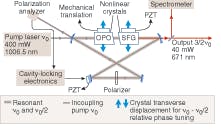HARMONIC GENERATION: 3/2 conversion accesses green to red wavelengths
For visible and near-infrared light, diode-laser technology directly accesses the entire spectral range of 730 to 1100 nm, plus isolated wavelength ranges in the red and violet. While second-harmonic generation extends the reach of diode lasers to the 370-to-550 nm spectral range, a large part of the visible spectrum from the green to the red remains accessible only through more expensive and less practical optically pumped lasers. But using a new technique based on a multiresonant optical parametric oscillator (OPO) that is inherently phase-coherent and efficient, Gabriele Ferrari from the University of Florence (Florence, Italy) has spanned the green-to-red wavelength region by demonstrating optical frequency multiplication by a factor of 3/2.
The converter consists of an OPO in which the pump, signal, and idler fields are all resonant in a cavity that is operating at frequency degeneracy-a condition in which the signal and idler frequencies coincide. Because this OPO-generated field has half the frequency of the pump wavelength, radiation at 3/2 the pump frequency is obtained by using a nonlinear crystal in the cavity to sum the pump (1) and OPO (1/2) frequencies (see figure). The triple-resonance condition between the pump, signal, and idler fields reduces the threshold of oscillation on the pump intensity down to the milliwatt level and enables active stabilization of the cavity length with respect to the pump frequency.
Frequency multiplication was demonstrated with a 1006.5 nm pump laser composed of a semiconductor master-oscillator power-amplifier (MOPA) system with the antireflection-coated master diode laser stabilized on an extended cavity in a Littrow configuration. This 30 mW master laser with a linewidth of less than 500 kHz was amplified to 400 mW using a semiconductor tapered amplifier. The input mirror to the optical cavity had a 10% transmission at the pump wavelength. Apart from the input, all cavity mirrors were highly reflective at 1006.5 nm and the doubled 2013 nm wavelengths, while being highly transmissive at 671 nm. One of the folding mirrors was mounted on a piezoelectric transducer to stabilize the cavity length to the pump field resonance.
Tuning the resonance modes
Two wedge-shaped nonlinear crystals were inserted in the OPO cavity; displacing one of the crystals changed the optical path, allowing fine-tuning of the OPO resonance modes while keeping the cavity resonant with the pump field. When the double resonance and frequency-degenerate condition was reached, the OPO generated 671 nm light.
Analysis of the red output light with a confocal Fabry-Perot spectrometer revealed that by changing the transverse position of the crystals by tens of microns, it was possible to switch between single-frequency emission at 671 nm and multifrequency emission with the central wavelength displaced by as much as 0.080 nm from the 671 nm nominal wavelength. While the multi-longitudinal-mode operation was stable for time scales on the order of hours, the single-frequency emission was stable at scales on the order of minutes. Improved stability is expected if a thin etalon that is effective for the OPO field only is placed inside the cavity. The single-frequency emission had a 1.5% root-mean-square measured amplitude noise on a 50 kHz bandwidth, and exhibited 30% conversion efficiency.
“This idea came about from the struggle of researchers in the field of atomic and molecular spectroscopy who were forced to use dye lasers to access visible radiation wavelengths,” says researcher Gabriele Ferrari. “But it turns out that potential applications are much broader, spanning the metrology of optical frequencies to the simplification of high-power RGB lasers. With the support from Rudi Grimm from the University of Innsbruck, Austria, Leos Solutions (Strada in Chianti, Italy), and Sacher Lasertechnik (Marburg, Germany), we can implement the frequency multiplier in a stand-alone laser source, demonstrating its application in many fields.”
REFERENCE
1. G. Ferrari, Optics Express 15, 4, 1672 (Feb. 19, 2007).

Gail Overton | Senior Editor (2004-2020)
Gail has more than 30 years of engineering, marketing, product management, and editorial experience in the photonics and optical communications industry. Before joining the staff at Laser Focus World in 2004, she held many product management and product marketing roles in the fiber-optics industry, most notably at Hughes (El Segundo, CA), GTE Labs (Waltham, MA), Corning (Corning, NY), Photon Kinetics (Beaverton, OR), and Newport Corporation (Irvine, CA). During her marketing career, Gail published articles in WDM Solutions and Sensors magazine and traveled internationally to conduct product and sales training. Gail received her BS degree in physics, with an emphasis in optics, from San Diego State University in San Diego, CA in May 1986.
